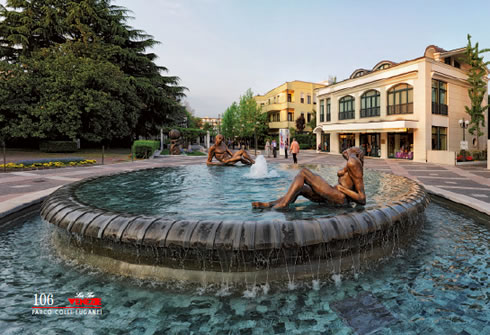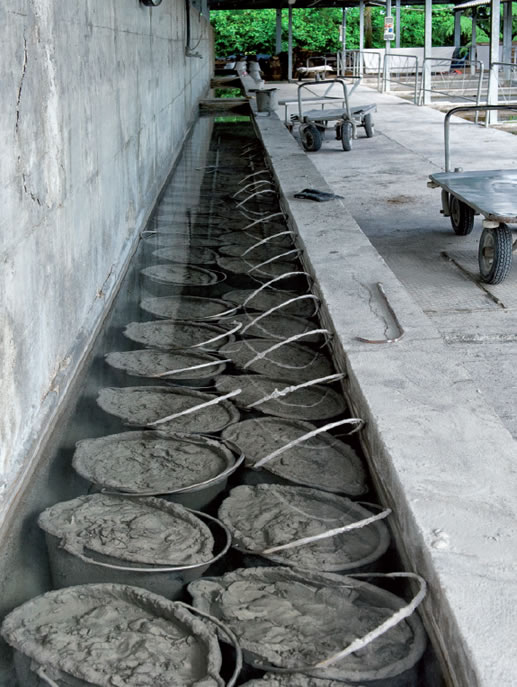BARBARA FABBRISGiornalista
Parco regionale dei colli euganeiTERME EUGANEEil più grande polo termale d'europa
|
|
La più grande stazione termale d'Europa è circondata dal verde abbraccio dei dolci Colli Euganei, oasi naturalistica straordinaria. Un mix irresistibile per chi ama sentirsi in forma e vivere all'aria aperta. Le terme sono sempre state viste come mete di vacanza per i "sofferenti", i malati, per coloro che essendo anziani e colpiti da numerosi dolori cercano in una stazione termale un po' di sollievo grazie agli effetti benefici che quest'acqua contiene. Oggi si cerca, invece, di rilanciare le terme come meta di benessere, di relax anche per chi non è affetto da problemi articolari e motori, ma nutre, principalmente, il desiderio di una vacanza "alternativa" dedicata al completo rilassamento e al benessere psicofisico, il tutto in una formula di pochi giorni (week-end o long week-end). Il culto del corpo e del benessere è sicuramente un valore da recuperare per poter poi affrontare la routine lavorativa quotidiana con una carica di energia in più. La cura di sé o il sano edonismo è uno dei valori che porta il turista a scegliere una vacanza termale magari in un ambiente silenzioso e a contatto con la natura come quello del Parco Regionale dei Colli Euganei, un territorio ricco di tradizioni e di cultura interessante anche per un tipo di turismo eno - gastronomico.
Alle Terme Euganee le acque benefiche e salutari sgorgano da oltre tremila anni, dando vita alla più grande e rinomata stazione termale d'Europa. La forza benefica di queste acque è alla base di tutti i più moderni trattamenti terapeutici ed estetici effettuati negli oltre 120 hotels termali, dove ogni ospite è accolto e seguito con la massima professionalità e cordialità. Le Terme Euganee sorgono in un ampio bacino ai piedi dei Colli Euganei, splendido anfiteatro verdeggiante, dove alla ricca vegetazione spontanea che alterna macchia mediterranea a fitti boschi, si intrecciano vigneti, oliveti, vasti prati e un'ampia rete di sentieri percorribili a piedi, in bicicletta o perfino a cavallo. Tremila anni di storia hanno lasciato in eredità a queste terre un patrimonio storico-artistico immenso. I castelli e città murate sono le mete ideali per un tuffo nel Medioevo; le ville nobiliari con i loro antichi giardini sono luoghi privilegiati per ammirare maestose ed eleganti architetture; e non dimenticate di girovagare tra i loro raffinati giardini o i rigogliosi parchi, ricchi di essenze, spesso secolari. Il segreto è nell'acqua, che partendo dagli incontaminati bacini delle Prealpi, a circa 2000 m. d'altezza, dopo un lungo percorso sotterraneo, durante il quale si arricchisce di sostanze minerali particolarmente benefiche (tra cui sodio, potassio, magnesio, iodio e silicio), riaffiora nel territorio delle Terme Euganee ad una temperatura di 87°. Quest'acqua, unica al mondo, è alla base del processo di maturazione, conservazione e rigenerazione del fango termale, ineguagliabile per le sue proprietà salso-bromo-iodiche e le capacità terapeutiche. Una ricchezza, quella dell'acqua termale, che contraddistingue il bacino termale euganeo da millenni con una continuità che ha radici nella lontana protostoria e si è mantenuta inalterata fino ad oggi. Gli antichi paleoveneti avevano qui un loro santuario lacustre particolarmente frequentato tra l'VIII ed il III secolo, come dimostrano i reperti archeologici consistenti in migliaia di vasetti fittili e piccoli bronzi votivi. In epoca romana, tra il I ed il II secolo d.C., la Fons Aponi (Sorgente di Apono, divinità legata all'acqua) divenne uno dei più importanti e famosi centri termali, già utilizzato a fini curativi e sede anche del misterioso culto dell'oracolo di Gerione, a cui si sarebbe rivolto anche il giovane Tiberio, futuro imperatore, per ottenere le sortes dal lancio dei dadi nella fonte sacra. Le terme furono apprezzate anche dagli invasori barbari, soprattutto da Teodorico, e dopo l'anno Mille si riaffermò un grande interesse nei confronti della zona termale con lo sfruttamento di nuove sorgenti: san Daniele in Monte e Montirone ad Abano, i bagni della Stuva a Battaglia. Gli illuminati e colti signori Da Carrara, principi di Padova per quasi tutto il Trecento, avviarono importanti studi sui fanghi, poi continuati dalla scuola di Medicina dell'Università di Padova fino al Settecento, quando vennero istituite due nuove cattedre espressamente dedicate allo studio del termalismo.
Colli Euganei Regional Park Abano Terme, fountain in the pedestrian area. The largest area of thermal springs in Europe is surrounded by the green embrace of the rolling Euganean Hills (Colli Euganei), an extraordinary natural oasis with an irresistible appeal for those who want to be healthy and enjoy the open air. Spas were traditionally seen as holiday destinations for the "sick", for people who, either elderly or affected by various pains or infirmities, sought at a spa relief thanks to the beneficial effects of their waters.
|
|
AQUAE PATAVINAE >>>>>
Potete ordinare la vostra copia del "Parco dei colli euganei" online oppure lo trovate in edicola e potrete godervi le immagini ad alta risoluzione. Contattateci per eventuali richieste.
 |
Le Tre Venezie Editoriale Via Zermanese 161, 31100 Treviso, tel e fax: +39 0422 404807 |



